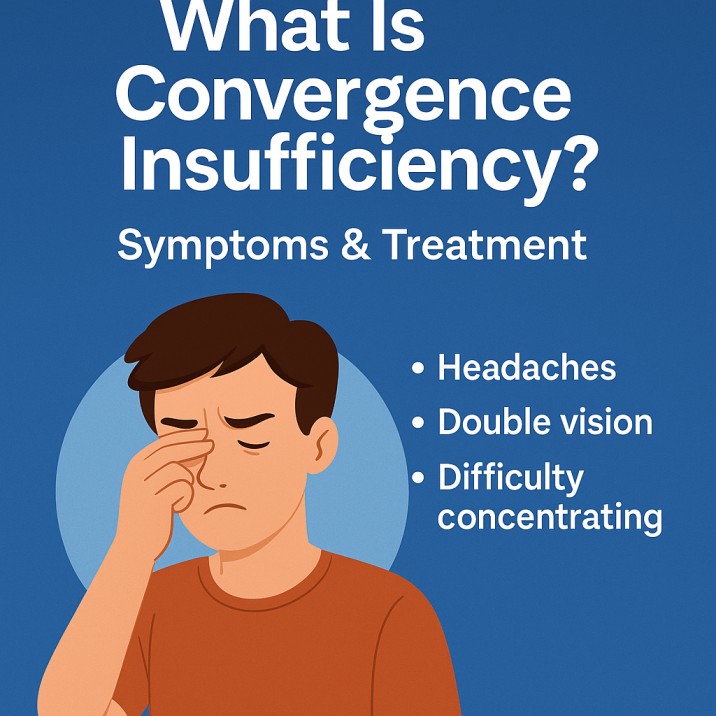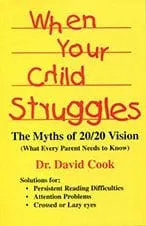Convergence Insufficiency Therapy
Say Hello to Reading. Say Goodbye to Eyestrain and Headaches
Convergence insufficiency (CI) is a common reason bright children and adults struggle with reading, homework, or screen time. At Cook Vision Therapy Center in Marietta, Georgia, we specialize in evidence-based solutions to transform reading discomfort into lasting relief.
“When I came to vision therapy, I had severe headaches daily. I could not read for longer than about 5-10 minutes before words began to blur and run together. Since I’ve been in therapy, I have not had a headache. I have noticed that each time I pick up a book (which I now enjoy doing) I read several chapters before stopping. My eyes no longer tire after a few paragraphs. “
What is Convergence Insufficiency?
Convergence is the eyes’ ability to team together to focus on near objects, like books or screens. Convergence insufficiency occurs when the brain struggles to coordinate the 14 eye muscles responsible for clear, comfortable near vision. This leads to symptoms like headaches, double vision, and difficulty concentrating during reading.
Symptoms
According to a National Eye Institute gold-standard study, which included the Mayo Clinic among its treatment centers (Randomized Clinical Trial of Treatments for Symptomatic Convergence Insufficiency in Children: Archives of Ophthalmology, Vol. 126, October 21, 2008), convergence insufficiency can be associated with any or all of the following symptoms during reading or doing near work:
- Eyes feel tired
- Eyes feel uncomfortable
- Eyes hurt
- Headaches
- Loss of concentration
- Trouble remembering what you have read
- Double vision
- The words move, jump, swim, or appear to float on the page
- Read slowly
- A “pulling feeling” around eyes
- Words blurring or coming in and out of focus
- Loss of place
- Rereading of the same line of words
Best Treatment
In the same National Eye Institute study, one group was fooled into thinking they were receiving vision therapy (placebo group). During a twelve-week trial, the placebo group was compared to three other groups:
In-office vision therapy training flexibility between the muscles, keeping things clear, and the muscles keeping things single (relative convergence and relative accommodation)
- Converging to look at a pencil held close to the nose
- Home computer program
Thirty-five percent of the placebo group, 33 percent of the computer group, 43 percent of the pencil group, and 73 percent of the in-office-vision-therapy group improved at converging their eyes to look at a pencil. When it came to reducing symptoms of “loss of concentration,” “headaches,) etc. only the in-office vision therapy group performed better than the placebo group. Reviewing the study, a Mayo Clinic press release stated that In-Office Vision Therapy is the preferred treatment for convergence insufficiency.
Top 5 Causes of Convergence Insufficiency
-
Neurological Signal Breakdown: The brain fails to send precise cues to healthy eye muscles, impairing coordination.
-
Brain Injuries: 30% of concussion patients develop CI, per a 2023 Journal of Neuro-Ophthalmology study, due to nerve disruption.
-
Neurodegenerative Diseases: Parkinson’s, Alzheimer’s, and myasthenia gravis damage nerve pathways critical for eye alignment.
-
Genetic Predisposition: Family history may increase CI risk, though research is ongoing.
-
Systemic Conditions: Graves’ disease and autoimmune disorders often correlate with CI onset.
Why Early Diagnosis Matters
Identifying CI’s root cause—whether neurological, injury-related, or genetic—empowers patients to:
-
Seek vision therapy (e.g., personalized eye exercises)
-
Address underlying conditions (e.g., concussion rehab)
-
Use AI-driven tools like binocular vision apps for symptom tracking
Convergence Insufficiency & Learning: Why Early Intervention Is Critical
Convergence insufficiency (CI) isn’t just a vision problem—it’s a hidden barrier to learning for 1 in 10 school-aged children, per the American Academy of Ophthalmology. When eyes can’t align for close tasks like reading, students face:
Top 4 Learning Challenges Linked to CI
-
Reading Struggles: Words may blur, double, or “float,” forcing kids to reread lines or skip text.
-
Eye Fatigue: 60% of children with CI report headaches after 20 minutes of screen/reading time.
-
Attention Decline: Visual strain reduces focus, mimicking ADHD symptoms (studies show 35% of CI cases are misdiagnosed).
-
Academic Confidence Loss: Falling behind peers often leads to frustration and avoidance.
Breaking the Cycle: Vision Therapy & Modern Solutions
-
Personalized Vision Therapy: 72% of children improve reading speed after 12 weeks of structured exercises, like pencil push-ups or computer-based tracking drills.
-
AI-Powered Tools: Apps like EyeSpy 2025 gamify eye coordination training, making therapy engaging for kids.
-
Classroom Accommodations: Use dyslexia-friendly fonts or blue-light filters to reduce strain.
Our Approach
At Cook Vision Therapy Center, we combine 30+ years of expertise with the latest research to deliver lasting results:
-
Customized In-Office Therapy: Build flexibility between eye muscles using proven techniques from the NEI study.
-
Integration of 7 Visual Abilities: Beyond convergence, we train focusing, tracking, and depth perception.
-
Mastery-Based Training: Skills become second nature, ensuring long-term success after treatment.
Led by Dr. Cook, a pioneer in vision therapy who has trained doctors nationwide, our Marietta clinic offers unmatched expertise.
FAQs About Convergence Insufficiency
-
Can convergence insufficiency be cured?
Yes! 73% of patients in clinical studies achieved significant improvement with in-office therapy.
-
How long does treatment take?
-
Is vision therapy covered by insurance?
-
What is convergence insufficiency therapy and how does it work?
-
Where is convergence insufficiency therapy performed?
-
Why is vision therapy preferred over glasses or surgery for convergence insufficiency?
-
How can I tell if convergence insufficiency therapy is working?
-
What exercises are commonly used in convergence insufficiency therapy?
-
Can convergence insufficiency cause headaches and blurry vision?
-
Are there any risks or side effects from convergence insufficiency therapy?
-
Can adults benefit from convergence insufficiency therapy?
-
How often should home exercises be done for best results?
Check Out Our Resources
Dr. Cook’s Publications:
- Authored books VISUAL FITNESS and WHEN YOUR CHILD STRUGGLES.
- Published articles in top optometric journals.
- His article “Eyesight, infinity and the human heart” was voted “Best Non-Technical Article” by the Association of Optometric Editors.




